Things I wish I knew when I started trading [Risk management]

A take on managing risk as an active trader.
Contents :
1.Risk management
Consistency is paramount
With discipline comes consistency and with consistency comes profitability.
2.How stop-loss and take-profit help
What is a stop loss?
Understanding why stop hunting happens
Why you are getting stop hunted?
Tips on how to avoid getting stop hunted
Where to put stop loss?
Example 1:
Example 2:
Example 3:
Trailing stop losses (TSL)
Sum up
3.Resources that really helped me out since I started:
1. Risk management
Let you winners run and cut your losers early
Risk management is an essential but often trivialized prerequisite to successful active trading. You stand to lose more in a few minutes than you have gained in several days if the proper risk management isn’t employed.
Sun Tzu’s book the Art of War, has many teachings that echo in trading, from how deception is used to confuse retail traders and lead them to mistakes, to the fact that planning and strategy - not battles- win wars. Any amount of micromanagement in the world won’t matter if your trading plan has been totally wrong from the get-go. As many traders commonly advice, ‘Plan the trade and trade the plan’.
Consistency is paramount
A winning trader is a one who picks a trading plan that suits him and develops his execution to perfection. If you don’t have a trading plan and are all over the place, not only you won’t be able to distinguish between justified wins and unjustified wins but you will also be the guy that’s trying to get good at everything at once. You only have a finite amount of time and focus, and it takes a lot of effort to be good at something so you better pick carefully what you want to be good at. I vididly remember this quote from the show ‘shark tank’ which resonates quite well here.
‘Man you are fighting so many battles,
Look a guy that used to work for me,
he was at one point actually the 11th fastest man in the world,
I run 5 miles a day so I used to say- hey let’s go running,
And he would say to me- I can’t run 5 miles,
I said -common man you are in great shape, you can run 5 miles,
-- I don’t run 5 miles I run 100 meters as fast as I can, that’s my job.’
One must trade consistently by following a specific trading plan on each and everyone of his trades.
If you trade one way this time, and another on the next one, you will be running all over the place- and so will be your performance. Plus you won’t get to know what actually works and what doesn’t due to your low sample size on each approach and statistical variance.
With discipline come consistency and with consistency comes profitability.
Don’t let your ego or unrealistic returns get in the way of maintaining your discipline. If you start with a $1000 account, don't expect to be living off that. Follow your trading plan, and anchor within you the idea that if you follow your plan- in the long run, you will follow the money.
2. How stop-loss and take-profit help
Stop loss and take profit orders represent 2 fundamental ways with which traders can plan ahead. Successful active traders have rock solid discipline, they plan every one of their trades invariably, and then trade their plans. Unless you develop clearly defined trading plans and strategies to follow, manage and optimise- you will find gaining consistency quite difficult. It’s really important that you build a feedback loop with your trading plans that feeds and prospers off your discipline. When you stop following your plans, you get rewarded for a lack of discipline and will find yourself getting more and more reckless with your gambles. I’ve lost more in a couple hours due to not putting stop losses, that I’ve gained in whole weeks. Successful traders know their entry and exit prices, and they measure the probability of the potential profit against the probability of the price hitting their stop. If the reward/risk ratio is high enough, they take the trade. Don’t get me wrong, they might lose 5 trades in a row, there are always clusters of losing trades, but they take it all back and even more in the long run.
Setting stop loss and take-profit orders is often done using technical analysis, but fundamental and sentiment analysis can also play a key part in timing the entry. Setting stop-loss and take-profit orders is also essential in calculating the expected return of a trade, whose importance cannot be overstated since it forces you to rationalize your decisions. Have you ever had the experience of speaking to a relative or friend about why you got into a trade, and maybe why they should come along as well? You get into the process of analyzing and weighting things and these tend to be more often than not, winning trades. It’s the same thing here but instead you are doing this consciously with yourself, every single time.
The expected return (ER) can be calculated as followed:
(ER) = [(Probability of profit) * (% Profit) + (Probability of loss) * (% Loss)]
What is a stop loss?
A stop loss is a counter order to your position with the aim of limiting your losses by exiting the trade. A stop loss order takes the emotion out of trading decisions and can also be really useful when a trader can’t constantly monitor his position, (e.g during the night). For instance if you own bitcoin which is currently trading at $6450 you can mitigate your loss by setting a stop-loss order at $6050, that means that should the price reach $6050 it’s going to trigger a market sell order and sell at the best available bid . In contrast, a short-seller can also use stop-loss by putting the stop-loss above his initial entry price in order to cover his short position.
If you are a beginner trader 100% of the trades you take should have a stop loss, and at least 95% should have a take profit. Capital conservation is of paramount importance in the initial stages of trading , because it will take a lot of experience, researching and trial & error to find a profitable strategy and become a consistently good trader, so you don't want to gamble it all away at a time stage where you know the least. I got into crypto trading 2 months ago, fiat--> gdax then transferred the btc to binance. I picked binance mainly due to their low fees, and ability to trade a variety of altcoins on decent volume. The UI is pretty straightforward and you can dive into it within the first 10 minutes, something which can’t be said for two other exchanges that I tested at that time, namely bitmex and cryptopia. However the caveat is that due to the way that orders work on binance, you can’t have simultaneous stop loss and take profit orders on the same position. It was alright during the day when I was home and could monitor the trade but my hands were tied in night-time So what I initially did was set a stop loss and put a price notification on trading view, which would wake me up so I can take profit. I’m not saying that I hate alarms clocks, but I hate alarm clocks.
This went on for a couple days, and knowing that I had to do something about it- I took upon me to learn how to automate the process using the binance API. It didn’t take me long to realise that with my very limited programming skills I would have to prioritise either learning how to program or learning how to trade. I made my choice and I searched for crypto bots and went from free trial to free trial for a bit. Most of them were overcharging due to their ability to set up bots that would automate trades using commonly used indicators like MACD and RSI, while I only wanted the capability of setting simultaneous orders on binance positions.
Eventually I ended up picking exchange valet due to it’s simplicity and it being on my lower price range, which is a downloadable app with a 2 week trial period. For all the reasons above if you are starting out trading on binance I absolutely recommend it.
Understanding why stop hunting happens
Stop hunting is a strategy that attempts to force some weak hands off their positions by driving the price of an asset towards a level where many individual traders have chosen to put their stop-losses. This leads to cascading stop-losses and also new traders pilling in, trying to trade the breakout, which in turn offers institutions the much needed liquidity they need to complete their high volume transactions. If you are wondering what liquidity is, it basically quantifies the degree in which an asset or security can be bought on the market without affecting the asset's price. Think of liquidity like mass. Buying in a market with low liquidity would be like you casually pushing a bicycle down the road. While buying in a market with high liquidity would be like trying to move a 12 ton truck with your own two hands. The more liquidity, the more inertia, and the more harder it is for price to move.
You might think that stop hunts have some sort of nefarious objective, but they are just unfortunately a necessary evil of having big institutions trading. Big institutions have a huge problem in terms of that their capital power is also their curse. Sometimes when they want to take a trade and have huge orders to fill the issue is that there are not enough people on the other side of the trade to have that transaction complete. Institutional traders are taught from the first day that they buy good levels or they don’t buy at all, unfortunately most retail traders will wait for a confirmation before getting in.
The market is going to offer bait to try to get retail traders to emotionally market buy or market sell on places where they shouldn’t. The reason is that institutional traders prefer to use limit orders since most exchanges offer lower or 0 fees or even rebates, e.g (binance/gdax/bitmex). In contrast, if they were to market buy or market sell big volume, not only would they just eat up the asks/bids thus entering/exiting at progressively worse prices, but their moves would also be apparent to retail traders.
Institutional traders will buy at a level where most traders put their stop loss, a tick under the last low and they will invariably put their stop loss exactly where the institutional traders and crypto whales enter. If you are a casual trader and want to buy half a bitcoin you just press a little button and you got it. However, if you are trading with big volume it’s not that simple to get filled. The solution to this is liquidity pools which are located beyond support and resistance levels. So what they do is identify a location where they want to do business and then they manipulate the price around that location to hide their movements without moving the market much.
This is a fantastic video by Mark Chapman that condenses the concept of stop hunting.
Why you are getting stop hunted?
The point of trading is to make a lot of money with as little risk as possible. This loss aversion makes traders put stops way too tight compared to the initial entry price. Unfortunately, the closest you have the stop the more likely it is that it is going to be triggered. (There are exceptions where you can put a really tight SL). The stop should be at a place where the initial trade idea is invalidated. Keep in mind that mental stop loss levels are not the solution to not getting stop hunted.
You are putting you stop at the same level as everyone else. Markets hunt for those stop loss orders for liquidity. I.e you are putting your stop losses right on the support lines, this is often the wrong place to sell. You can do 2 things here, either enter with the stops and put your stop lower or wait and see what the other retail traders are doing and then decide on the trade. Flip the trade on it’s head and think like this: I would enter where my stop would normally be if I was already in, and go on from there. This doesn’t mean that you should blindly buy on lower lows and sell on higher highs.
The market doesn’t care where you put your stop loss. It moves from an area of liquidity to the next area of liquidity, and if you place your stop loss at a random level — it will get eaten alive.
Tips on how to avoid getting stop hunted
Trading is a massive psychological game. There are four main psychological states of emotion that drive most individual decision making in any market. These are fear, greed, regret and hope. Since markets are comprised of individual humans who tend to act similarly, then a group is formed. It is only the group’s opinions that matters in a trend, but it is up to the individual to identify the clues as to when a market is going to reverse direction. The clues are there but they are really subtle especially if you don’t know what to look for. A detailed understanding of these emotions goes a long way to keep a trader out of trouble and identify potential individual weakness.
With having that knowledge, one is steadily fighting a battle between the willingness to think independently and the desire to go along with the market momentum ( herd mentality). That is why we have trading systems. Their intention is to take out the emotion out of trading. If you are afraid to enter a quality setup out of fear or exit at market top out of greed, then there’s no point in trading.
Worth noting that often times a trade idea can be correct, yet the trade can still end up losing money because the timing is off. Let’s say you have a hunch that a downtrend reversal is coming, because you spotted multiple divergences. The market doesn’t just stop and reverse, it’s like an aircraft carrier. Switch off the nuclear reactors and the ship will continue for several miles. The selling pressure is so great that it first has to be absorbed before a reversal can occur. So your idea can be valid in the weekly time frames, but invalid for intra-day trading. Divergences indicate that something finicky is going on, but you can easily find out that they can run for a long time before reversal happens. Don’t get in a habit of trying to catch a falling knife, your 450 bucks won’t be enough to pull the market up by its legs and this is going to lead to a lot of pain and suffering by being trapped in a losing position.
Typical market psychology:
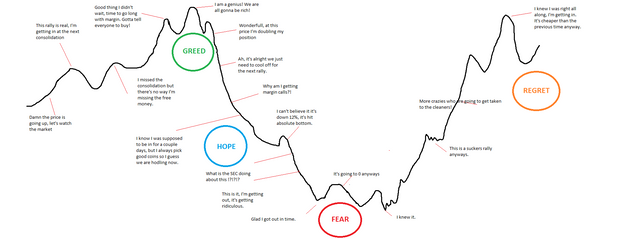
https://postimg.cc/image/i8ecle8qz/
• Never use obvious levels for your stops. Horizontal support levels and commonly used lagging indicators such as MAs, EMAs are what everyone looks at. If the market is free-falling to a support level you shouldn’t be blindly buying at it. Before any reversal you need to wait for the market to apply its breaks and absorb the selling pressure, what you are generally looking for is stopping volume to occur. The first major move against a trend is seldomly the start of a new trend.
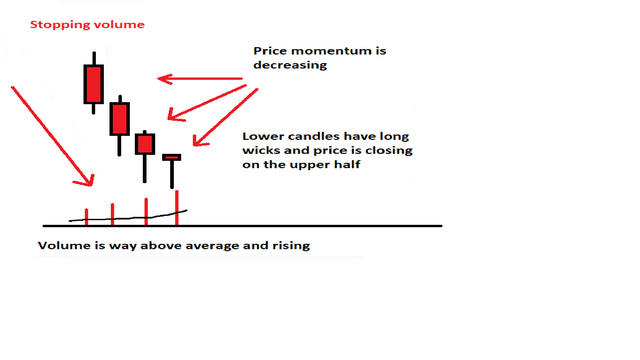
• People tend to love big rounded even numbers like $6000 for btc. They tend to put stop losses a few ticks below these prices and this leads to cascading stop losses which spread like wildfire until every single stop loss in that price range has been hit. An aggressive trader using order flow for confluence loves to buy these levels.
• Get in the head of the average retail trader, think like you would when you just started trading, then do the opposite.
• If a trade seems too good to be true, then it probably is.
• Identify liquidity areas, markets tend to move from one area of liquidity to another. Use volume profiles as an aid.
• If you find yourself having to risk a big % to put a proper stop loss then your entry price is probably not good.
• Use a trading journal to log your trades. Keep it simple.
I recommend getting accustomed to the core ideas of supply and demand, it’s essentially how the markets move. That’s why I’ve put a list at the end with the most valuable resources I’ve found since I started.
Where to put stop loss?
‘The stop needs to be where the stop needs to be’- David Paul
If you don’t think long and hard about where you are putting your stop-losses then you are going to find out that your capital can quite easily die a death by a thousand cuts. Markets will often go towards the obvious stops and these are usually really good entry positions.
Support and resistance zones are great ways areas to get into a trade, they are bounded areas that represent a price range where a lot of previous transactions occured. Usually price either bounces off immediately or consolidates for a bit there and then either continues the trend or reverses. Generally traders get good at one specific category of trading and perfect their execution, there’s lot’s of profitable traders who just trade S/R zones.
Example 1:
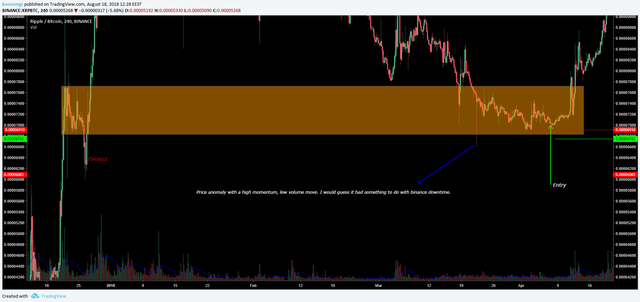
https://postimg.cc/image/tkqy3ohl7/
This is a chart of the XRP-BTC pair. At the end of 2017 XRP had a huge run. Price surged upwards on the 12th of December and at the left side of the chart you can see price consolidating for a week, struggling to go higher. This is a resistance zone which actually turned out to be a re-accumulation phase, (I disregarded the candlesticks below the drawn zone because that was a fake-out). After having a great bull-run, the price gradually fell down to that same area of previous resistance, but now it constitutes support since once support or resistance get breached they flip roles. Below is an example of BTC/USD showing this S/R flip.
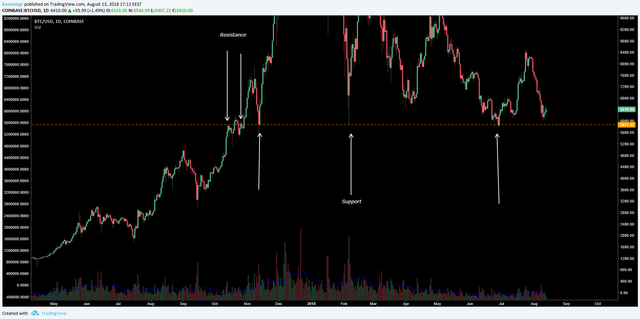
https://postimg.cc/image/eosevr62z/
With that in mind, having identified this previous resistance zone which now acts as support, let’s say you decide to swing trade at the green arrow. Price has been consolidating for two weeks here which indicates big accumulation of positions, either short or long. You never know what price will do by just looking at the support zone, but typically the first re-test of a support zone is the most likely to hold. In this case a bad stop loss would be right on the price of the previous low [red line] , a better one would be below the support zone [green line]. Respect market volatility. Given the duration of consolidation in this area [cause] ,you can alternatively wait for a break of market structure [ big price momentum breakout from the support zone with accompanying volume], and then trade the emerging trend [effect]. This is a good case of putting a good stop loss and letting it ride, close down your pc, go do something else and don’t let emotions get in the way.
Example 2:
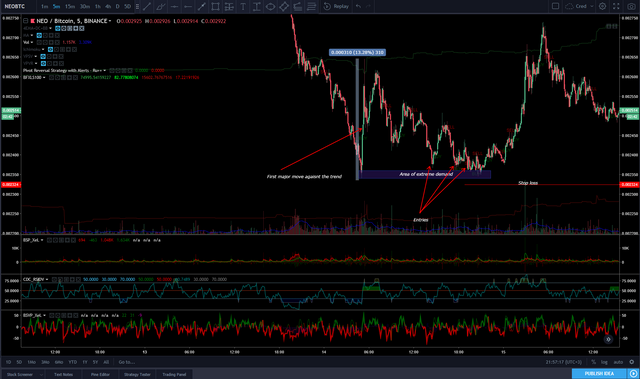
https://postimg.cc/image/b6gez4cu3/
The second example is of NEOBTC which has been downtrending on the weekly time frames for a while. I’ve been expecting this to reverse and I wanted to go long in the long term , I actuallyI expected it to bottom out at the 0.002800 level but I was wrong. Anyways here you can see the first sign of a major move against the trend, in fact it’s a nearly vertical +13% move in 20 minutes which is great news if you are planning on buying. Remember though, the first major move against a trend is rarely the start of a new trend. However, given the momentum of the move and how little the price stayed at the 0.002350 level, this indicates to me extreme untapped demand. Buying slightly above that area and putting your stop loss bellow the area would be fantastic from a reward/risk perspective. You risk 2% to gain at least 10%. The reason for putting a tight stop loss here is that I have high confidence in the premise of the trade [high demand area] but if it was wrong, I would need to get out asap.
Example 3:
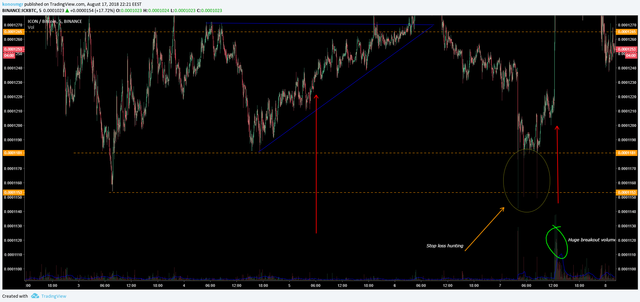
https://postimg.cc/image/67swkpbmz/
This example is actually from a couple individual trades I made, with the red arrow being my entry points. Having identified that the price has been consolidating in a channel I jumped on the trend on the first one, and sold at the resistance level that was formed by the previous highs. In the second one I got in because the market made a false break of a key previous swing point [long wicks that reach below the initial V shape swing low], and then closed well above it. This was an obvious stop loss hunting at the time as invariably a lot of traders put their stop loss either at the first or second orange lines. The whole promise of the trade is called SFP [Swing failure pattern] which I believe was first coined by trader Tom Dante. In both cases I didn’t put initial stop losses because I was monitoring the trades closely and given how manipulated the price seemed to be. Looking back, the first trade was certainly reckless because I wasn't following a trading plan.
Trailing stop losses(TSL)
It’s probably better to risk limiting your gains that risk losing your entire profit.
While you normally set a stop loss order at a specific price or percentage away from your entry, a trailing stop loss is a stop loss order that trails the current price upwards and acts as a safety net to secure unrealised profit. Let’s say you buy an asset for $100 and you set a trailing stop loss of 5%. Your current trailing stop loss level is (100-5)%$100=$95, if the price moves downwards the trailing stop loss will remain at $95.If instead it goes to $101 then the new stop loss level is (100-5)%$101=95.95, price increased by 1% and so does the TSL. As the market price rises a certain percentage so does the stop level.
Below is a typical example:
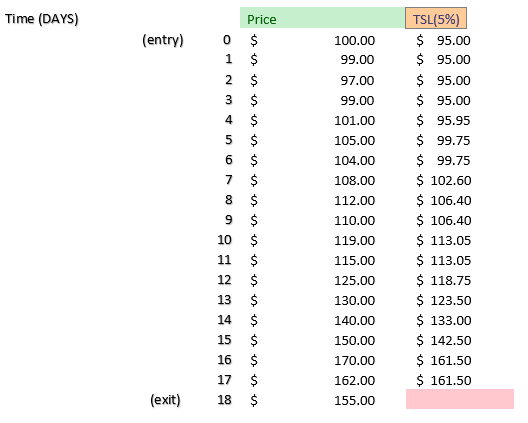
When the price fell to $161.50, the stop loss got triggered and your position got market sold at the next available price.
- You can also use a stop loss that instead places a limit order when it triggers but I wouldn’t recommend it.
The main reason I like to use TSL is to maximize gains on trades with overnight positions where I have reason to believe that the resistance level will not hold. The r/r ratio is usually worth it but you have to take into account the underlying asset’s daily volatility. Most of the time the market doesn’t simply move upwards in one big move, but dances like a sine wave. This ebb and flow will eat your TSL alive if you don’t respect the market’s volatility. One way to measure volatility so that you can pick a TSL % where it’s likely that you won’t get stopped would be the ATR indicator.
- You can also have the TSL trigger after a certain price.
Sum up:
• Give the market a bit of room to move around.
• Don’t pick stop losses out of thin air, because in volatile markets it’s gonna get eaten alive
• Don’t put your stop where everyone else is putting it. The market looks for that liquidity.
• Put at initial trade idea invalidation which has to be predetermined before entering a trade.
• Always stick to your original stop loss. If you start moving your stop loss down, you basically don’t even have one.
• Moving stop in any way that increases risk is forbidden.
• Must exit with the full position upon stop loss being triggered.
• Stop goes when you are wrong in this particular trade, not when you think you are wrong in the bigger picture.
• Market stop always.
• Enter/exit at a timeframe lower than the one you are trading for.
• Key areas tend to form when price revisits consolidation that led to an impulse move.
• If the market has no confidence, then it will trade to the previous area of liquidity.
Resources that really helped me out since I started:
- Books:
A Complete Guide To Volume Price Analysis-Anna Coulling
Βooks I’m planning to read:
- Fooled by Randomness: The Hidden Role of Chance in Life and in the Markets, Nassim Taleb
- The disciplined trader, Mark Douglas
- Reminiscences of a Stock Operator, Edwin Lefèvre
- Trading in the Zone: Master the Market with Confidence, Discipline and a Winning Attitude, Mark Douglas
- Zen in Markets: Confessions of a Samurai Trader, Edward Alan Toppel
- The complete turtle trader, Michael Covel
- Elliott Wave Principle: A Key to Market Behavior, A J Frost
- Technical Analysis Using Multiple Timeframes, Brian Shannon
- Sway: The irresistible pull of irrational behavior, Ori Brafman
- Market Wizards, Jack D. Schwager
- The power of now: a guide to spiritual enlightenment, Eckhart Tolle
- Online resources:
https://www.youtube.com/playlist?list=PLsGs-8LP59XadFME_lS3GkWjAHYqtWUYG
I can’t overstate how much I’ve learned off the youtube channel Bitcoin Trading Challenge.
- Useful sites:
• https://www.tradingview.com
• https://tensorcharts.com/
• https://datamish.com/d/000000004/btcusd?refresh=20s&orgId=1
• https://coinfarm.online/
• https://bitscreener.com/
And finally, this is a spreadsheet-which I found and tweaked a bit, that can act as a trading diary : https://docs.google.com/spreadsheets/d/1K3z6RKW_9Kr8Rgu7A4nSbGDZcPnSkqHqrtYSci8VJ64/edit?usp=sharing
Anyone that wants to use it go to file->make a copy, on the top left corner.
Congratulations @konosmgr! You have completed the following achievement on Steemit and have been rewarded with new badge(s) :
Click on the badge to view your Board of Honor.
If you no longer want to receive notifications, reply to this comment with the word
STOPDo not miss the last post from @steemitboard:
SteemitBoard and the Veterans on Steemit - The First Community Badge.